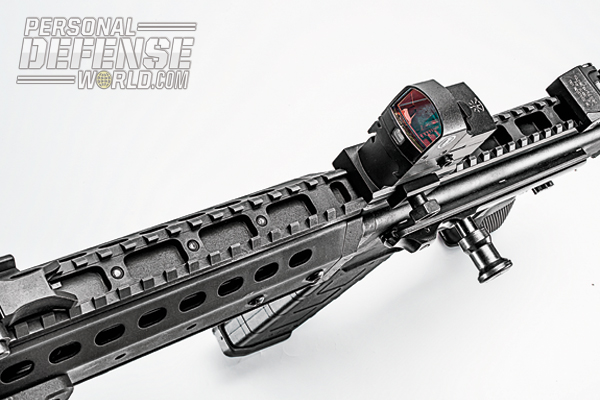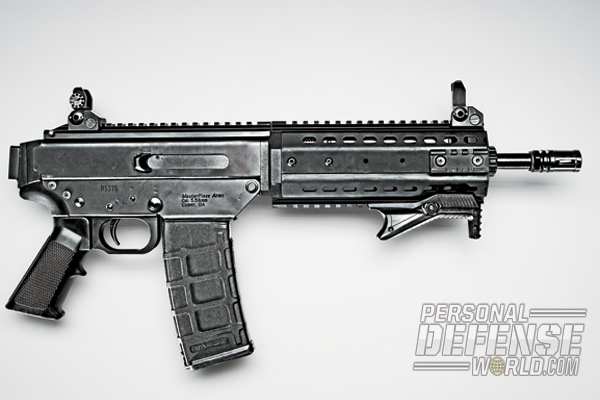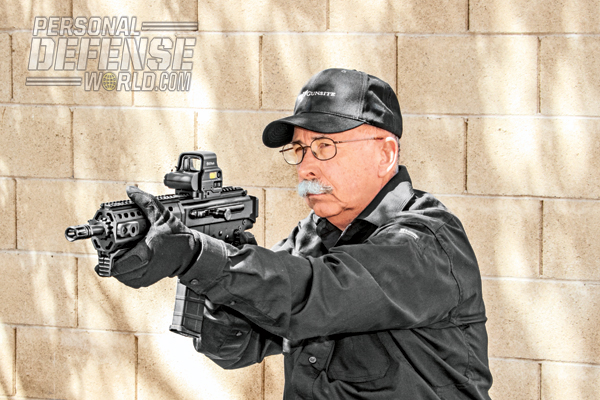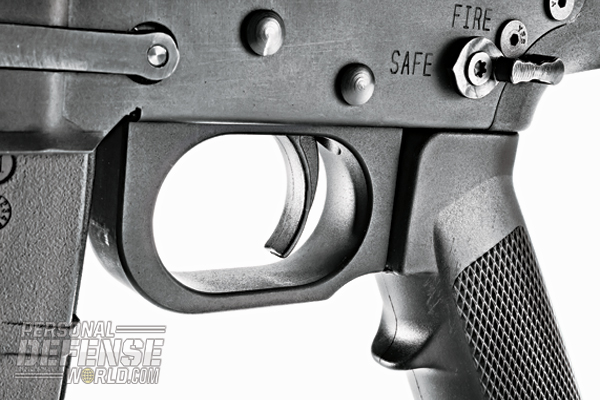If you want to attract attention, take the new MPAR556-P Pistol from MasterPiece Arms to the range. Some people will be curious about how well the gun shoots, others will automatically want one because it’s different, and others will wonder why in the heck anyone would bother with one of those curiosities.
Before getting into the details of the MPAR556-P, let’s discuss the usefulness of an AR pistol. First, if you want a gun to shoot just for fun and like something a little different, an AR pistol might be just right for you. On the other hand, if you are looking for a self-defense gun, don’t ignore the AR-style pistol.
In close quarters, an AR pistol is easy to maneuver because it’s short. Although it isn’t small enough to effortlessly carry discreetly, with some forethought and the right clothing it can be concealed. And around a vehicle it may be a good solution. That’s a concept that was embraced by the U.S. Army’s Research, Development and Engineering Command when, in the 1970s, it developed the M231 Firing Port Weapon, meant for armored vehicle crews who might have to fight in close quarters.
Advertisement — Continue Reading Below
Gun Details

So, the AR pistol has some specialized uses in self-defense. But the MPAR556 isn’t really an AR pistol. Of course it’s chambered in the most popular AR pistol cartridge, the .223 Remington round, and it’s about the same size except that it lacks the receiver extension tube—it’s not needed with this innovative design. It also has an 11-inch barrel, which is very common, an A2-style flash suppressor, an A2 pistol grip and an upper and lower receiver that resemble those of an AR. It also uses AR magazines.
At the same time, the MPAR556-P Pistol differs in a number of significant ways from an AR. Some of these differences may actually make it more desirable for some users. Others will just like the fact that it’s different. First, it’s a piston gun, not a direct gas-impingement design. That has some distinct benefits over a direct-gas gun, although some will argue about that. Because hot gasses are not introduced directly into the receiver, as is the case with a piston gun, the bolt carrier group remains cooler and cleaner, which extends the time between cleanings and parts replacement.
Advertisement — Continue Reading Below
But the operating and piston systems on the MPAR556-P Pistol aren’t like most AR piston designs. There are two recoil springs that ride on two guide rods that also support the bolt carrier group as it reciprocates. This design does away with the need for an AR buffer spring and the buffer tube. That means the MPAR556-P is shorter and a bit more maneuverable than an AR-style pistol.

The bolt carrier group consists of the recoil plate, recoil springs, recoil spring guide rods, bolt carrier, firing pin and bolt. To access the group for cleaning, the safety pin located at the top rear of the upper receiver’s accessory rail can be easily pushed out. That allows the metal tab of the recoil plate to be pushed forward, allowing the lower receiver to swing down, which permits the entire bolt carrier group to be removed from the rear of the upper receiver.
To remove the piston, the two-piece sheet aluminum handguard must be removed. The manual says that to do so, the muzzle device—the A2 flash suppressor—must first be removed with a wrench. Then, three screws are removed that secure the handguard to the upper receiver. At this point, the handguard can be pulled forward off the barrel, exposing the piston system. However, since the barrel is so short, there is very little room to clamp the barrel in a vise when removing the flash suppressor. A better way of getting to the piston system may be to remove the handguard by disassembling it. That would require the removal of several screws.
Advertisement — Continue Reading Below
Once exposed, it is obvious that the piston system is fairly simple, consisting of the gas block and the nozzle on which the piston rides, a connecting piece that sits behind the piston and the push rod. To remove that assembly, the push rod is pulled to the rear, which allows the connecting piece to be removed. Then it is easy to separate the push rod from the upper receiver and take the piston off the gas nozzle.
Besides the unusual operating system, the upper and lower receivers are made of sheet steel, not machined aluminum parts. This no doubt tends to reduce manufacturing costs. The steel parts are nicely finished in what appears to be black manganese phosphate, and the aluminum handguard appears to be finished with black anodizing.

The right side of the upper receiver has an oval ejection port and a brass deflector that is welded to it, but lacks a dust cover. On the opposite side of the receiver is a non-reciprocating charging handle that, when pushed inward, also serves as a bolt forward assist. The upper receiver has an accessory rail running from front to rear that mates with another accessory rail that runs along the top of the handguard. The bottom of the handguard sports an accessory rail that runs its 8-inch length. On the right side near the front of the handguard is a short, 2-inch accessory rail, and on the opposite side is a quick-detach sling swivel socket. All the handguard rails are attached with screws.
Advertisement — Continue Reading Below
The rails allow accessories like iron sights or optics, lights or lasers to be attached. Since this is a pistol, it is not lawful to attach a vertical foregrip. However, an angled foregrip comes attached to the lower side of the handguard and is accompanied with a letter from the Bureau of Alcohol, Tobacco, Firearms and Explosives indicating that it does not qualify as a vertical foregrip and is therefore legal. Some operators will like it and others not. If not, it’s easy to remove.
A note regarding the rails: The recoil lugs that form the slots do not run uninterrupted from one side of the rail to the other, so some Mil-Std-1913 Picatinny rail mounts, like those from LaRue Tactical, will not work since its lug is located in the center of the mount and will not contact the rail’s recoil lug. The result is that there is nothing to prevent the mount from moving fore or aft.
The 11-inch barrel is nicely finished in what appears to be black manganese phosphate. The feed ramps, while not the same as M4 feed ramp cuts, are deep and look like they should promote reliable feeding.
Advertisement — Continue Reading Below
The rotating safety and magazine-release button are located in the same places as those on an AR-15. Pressing the magazine release allowed the supplied magazine to drop freely from the magazine well, which has a beveled mouth to help guide the magazine home during a magazine change. The manufacturer cautions that some magazines, even when built within military specifications, may not function in the MPAR556-P Pistol. So, check the ones you want to use for reliability before using them. The test gun was supplied with one 30-round Magpul magazine.
The two-stage trigger broke at about 8.5 pounds after some take-up and a false break. It’s very similar to the feel of a GI trigger. And there is plenty of room in the triggerguard for use with gloves.
Range Time
Advertisement — Continue Reading Below

To test the gun for accuracy, I mounted an EOTech XPS3 Holographic Weapon Sight and fired the gun off a pistol rest from the prescribed distance of 25 yards. Accuracy, as one might expect from an 11-inch-barreled pistol, was good, with groups averaging about an inch or less.
Shooting the gun off-hand is a little difficult. If you can find a support to use, do it. If not, you will have difficulty steadying the gun to aim it, unless you are unusually strong and have very steady hands. To aid aiming off-hand, the company supplies a single-point nylon sling that can be looped behind the back and then connected to the quick-detach sling swivel socket located at the rear of the receiver. By pushing forward to create tension on the sling, the aim is steadied.
The MPAR556-P Pistol does have its place, certainly for fun and possibly for self-defense, but it’s a gun that may only appeal to niche audiences. The buyer should recognize its limitations as well as its virtues in order to make an informed purchase.
Advertisement — Continue Reading Below
For more information, visit http://www.masterpiecearms.com or call 770-832-9430.






































